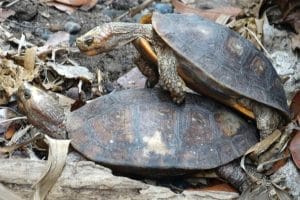Rhinoclemmys diademata (Maracaibo wood turtle)
Home > Turtle Database > Rhinoclemmys diademata (Maracaibo wood turtle)

Rhinoclemmys diademata, commonly known as the Maracaibo wood turtle, is a freshwater turtle native to Venezuela. This species is part of the Geoemydidae family and is known for its distinctive shell markings and semi-terrestrial lifestyle.
Native To These Regions
Apure (Venezuela), Arauca (Colombia), Barinas (Venezuela), Boyacá (Colombia), Falcón (Venezuela), Lara (Venezuela), Mérida (Venezuela), Norte de Santander (Colombia), Portuguesa (Venezuela), Santander (Colombia), Táchira (Venezuela), Trujillo (Venezuela), Zulia (Venezuela)Native Turtle Species Map – Find Turtles by Region
Scientific Classification
Kingdom: Animalia
Phylum: Chordata
Class: Reptilia
Order: Testudines
Family: Geoemydidae
Genus: Rhinoclemmys
Species: R. diademata
Common Names
Maracaibo wood turtle
This Hilarious Turtle Book Might Know Your Pet Better Than You Do
Let’s be real—most turtle care guides feel like reading a textbook written by a sleep-deprived zookeeper.
This one’s not that.
Told from the snarky point of view of a grumpy, judgmental turtle, 21 Turtle Truths You’ll Never Read in a Care Guide is packed with sarcasm, sass, and surprisingly useful insights.
And hey—you don’t have to commit to the whole thing just yet.
Grab 2 free truths from the ebook and get a taste of what your turtle really thinks about your setup, your food choices, and that weird plastic palm tree.
It’s funny, it’s honest, and if you’ve ever owned a turtle who glares at you like you’re the problem—you’ll feel seen.
Identification
Description
The Maracaibo wood turtle has an elongated, slightly domed carapace with dark brown or black markings on a lighter background. The plastron is usually yellowish with dark blotches. Its head is narrow with light-colored stripes extending from the snout to the neck.
Sexual Dimorphism
Males are generally smaller than females and have a longer, thicker tail. The plastron of males is slightly concave, while females have a flatter plastron.
Check more turtles from the Rhinoclemmys genus
Native Origin and Distribution
Geographical Range
This species is found in northwestern Venezuela, particularly around the Maracaibo Basin. It is primarily restricted to lowland areas with access to freshwater sources.
Preferred Habitat
The Maracaibo wood turtle inhabits tropical forests, wetlands, and riverbanks. It prefers areas with both terrestrial and aquatic environments, allowing it to bask on land while staying close to water for hydration and feeding.
Behavior
Feeding Habits
This turtle is omnivorous, consuming a diet of fruits, leaves, small invertebrates, and occasionally carrion. It forages both on land and in shallow water.
Predators
Natural predators include birds of prey, large fish, and mammals such as raccoons. Hatchlings are especially vulnerable to predation.
Reproduction
Breeding Season
The breeding season occurs during the rainy months when food availability is high.
Reproductive Method
Females lay a small clutch of eggs in sandy or soft soil. Incubation time varies depending on temperature and humidity levels. Hatchlings emerge fully developed and independent.
Conservation
Extinction Status
The Maracaibo wood turtle is classified as Least Concern.
Threats
Deforestation, pollution, and illegal collection for the pet trade pose major threats. Habitat destruction due to agricultural expansion further endangers the species.
Conservation Measures
Some protected areas exist within its range, but more conservation efforts, such as habitat preservation and stricter trade regulations, are needed.
Economic Importance
This species is sometimes collected for the pet trade due to its unique appearance. However, its economic impact is limited compared to other more commonly traded turtle species.
Interesting Facts
- Unlike fully aquatic turtles, this species spends a lot of time on land, making it more adaptable to different environments.
- It gets its name from the Maracaibo region, where it is primarily found.
- The species is part of a larger group of wood turtles known for their hardy nature and terrestrial tendencies.

About Author
Muntaseer Rahman started keeping pet turtles back in 2013. He also owns the largest Turtle & Tortoise Facebook community in Bangladesh. These days he is mostly active on Facebook.














